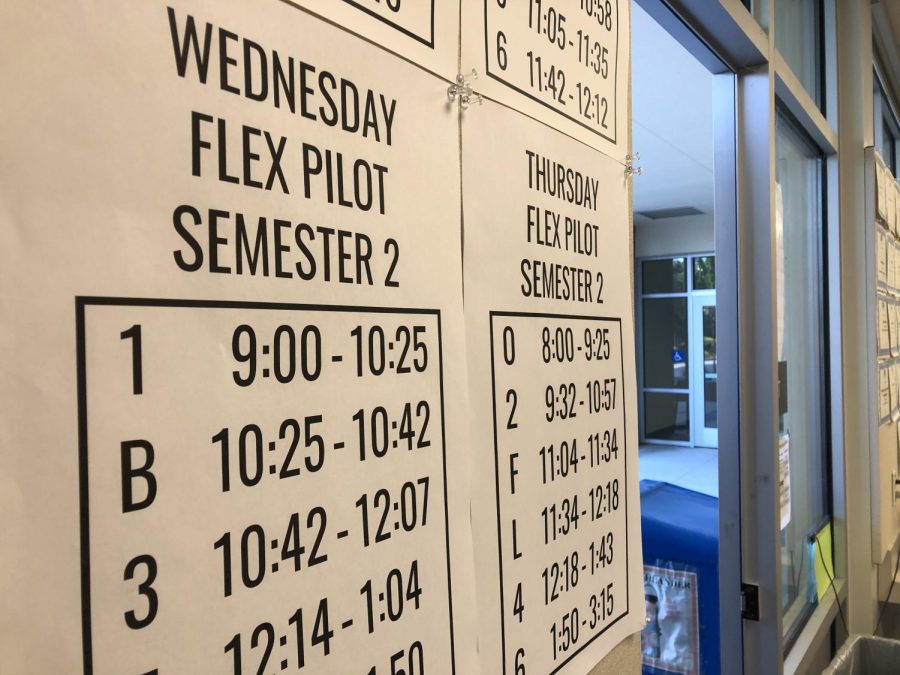By now, a majority of students and faculty know that the second semester’s pilot bell schedule has run its course. Due to widespread dissatisfaction with the elimination of late start, implementation of brunch, and particularly delayed lunchtime, a newly-developed Wednesday schedule will go into effect on Mar. 2, 2020.
Now, with this new Wednesday schedule, it seems the only difference between the first-semester pilot and the second-semester pilot 2.0 is the length of the flex period; while 40.4% of students believe the 50-minute Wednesday flex is too long, according to a recent survey of 1,222 Carlmont students, 49.3% either think 50 minutes is the ideal amount of flex time or enjoy having one long and one short flex.
However, for a variety of reasons, we believe it would be in the best interest of students and faculty to adopt the block schedule similar to that modeled during first semester. In order to determine the implications of retiring the five-day traditional schedule, we must look at the factors that prompted the administration to pilot a new schedule in the first place.
“The bell schedule has been discussed probably ever since Carlmont existed, so this is a long-standing ongoing discussion because Carlmont is one of the only schools on the peninsula and in Northern California that has a traditional schedule; most of the schools have some sort of either modified block or block schedule,” said Jennifer Cho, Carlmont’s instructional vice principal.
According to Cho, it seemed that every time there was a change in administrative leadership, the question of implementing a block schedule almost always came up; however, until last year, the idea never progressed into action. After talking to Principal Ralph Crame, the two agreed that the only way to have a productive conversation would be to see it in action and examine the schedule’s impact on the “Carlmont community, facilities, courses, and population.”
This specific conversation was further propelled by the Western Association of Schools and Colleges’ (WASC) committee recommendation.
“It was a recommendation from the committee that ‘yes, we can try different instructional techniques and we can try different courses, but really, we should look at the foundation of the school,'” Cho said.
According to Crame, the three critical areas of need (CANs) that WASC identified in their report were “improve academic achievement for underperforming subgroups, improve the preparation of students for post-secondary life career and adult responsibilities, and improve overall student mental health.” Crame, as well as the committee, believed that incorporating flex time into a block schedule would adequately address all three CANs.
“For CAN number one, it gives students that are in those underperforming groups the ability to meet with teachers during the school day. For CAN number two, flex time is a model where students have to make appointments with their teachers, much like it would be in college where if you’re falling behind in a subject, you’re going to have to make an appointment with your professor,” Crame said. “For number three, with mental health, we feel that giving students and teachers time at lunch to eat and not have academic pressure will allow them to have a little less stress throughout their day knowing that on the flex days, they have time to come in and make up any assignments they’ve missed.”
According to a survey taken by 1,369 students at the end of the first semester, the block schedule and implementation of flex time have successfully addressed these CANs; the survey showed that over the course of the month, 56.1% of students never had to miss instruction time to make up exams or projects, most likely due to flex time, and another 33.1% only missed at most two days of instruction for make-up assignments.
As intended, the new schedule has also allowed students to eat rather than study during lunch, as 48.4% of students report that they did not spend any lunches working with teachers, and 60.7% claim that four to five of their lunches throughout the week were dedicated solely to eating and taking a break from school.
Another difficulty that students tend to encounter with the traditional schedule is a lack of time to meet with counselors, especially during course selection and college application season. Flex time, therefore, gives such students the opportunity to meet with their counselors without missing class to do so. For seniors specifically, the extra period allows them time to fill out college applications and seek help in the college and career center, in order to ease the oftentimes overwhelming process.
There are a few inconveniences to the schedule, namely that students are not always able to see the teacher they need to because of limited capacity in each classroom. However, in general, students report that they are able to meet with teachers they need to see most, are less stressed by academic responsibilities than previously, and ultimately enjoy having flex time.
Furthermore, the numbers don’t lie. Despite any supposed dissatisfaction expressed by students regarding longer class periods, an earlier late start, or just a general dislike for flex, we believe it is time to retire the traditional bell schedule.
Not only have teachers already adjusted their lesson plans to accommodate the new schedule, but only 11.1% of students are against continuing flex next year. In the democratic society we live in, it is only fair to side with the majority, the 66.2% of students who would opt to continue with flex.
While 71.4% of students prefer the semester one pilot schedule over semester two’s, the new and improved schedule being piloted for the rest of the year leaves only one more question: will students opt for 20 more minutes to sleep, or 20 more minutes of flex time?
*This editorial reflects the views of the Scot Scoop editorial board and was written by Veronica Roseborough.













